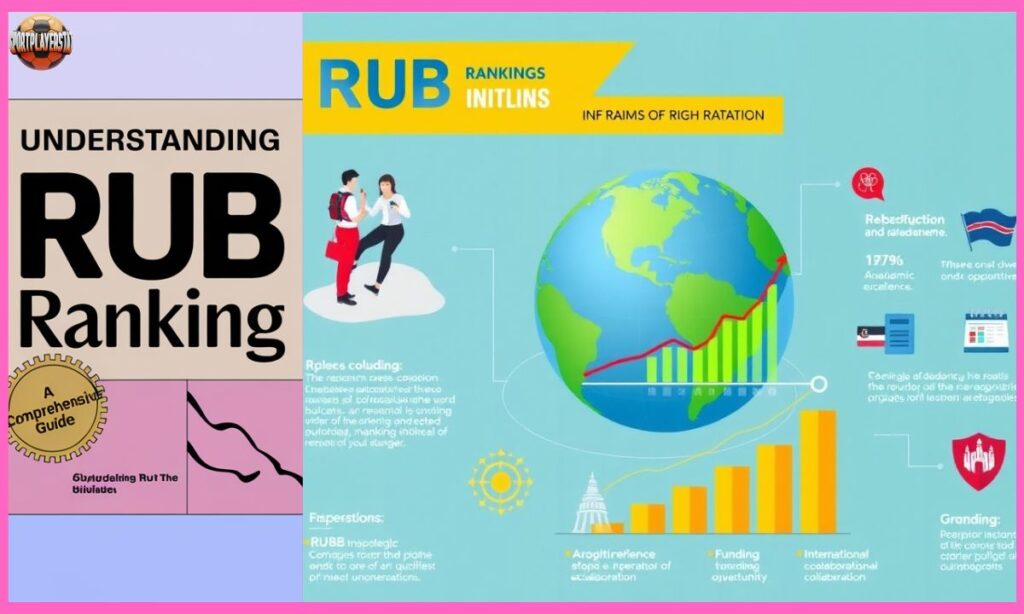RUB Rankings evaluate universities worldwide, providing insights into their performance. These rankings are essential for students, educators, and policymakers alike.
Imagine choosing a university that aligns with your academic goals. RUB Rankings can guide you to the best institutions for your future.
Introduction to RUB Ranking
RUB Rankings, or the Ranking of Universities in the World, evaluate universities globally. They provide insights into academic performance and institutional reputation. The rankings are vital for students, educators, and policymakers alike.
These rankings emerged to guide prospective students in selecting institutions. They also help universities assess their strengths. The RUB Ranking system has become a reference point for educational quality worldwide.
The importance of RUB Rankings lies in their ability to highlight institutional performance. They reflect the diverse aspects of education beyond just research output. As such, they offer a more rounded view of university capabilities.
Methodology Behind RUB Ranking
The methodology of RUB Rankings employs a comprehensive approach. It includes various metrics that assess university performance objectively. This systematic framework ensures transparency and fairness in evaluation.
Key indicators in the methodology include academic reputation and research output. Surveys among academic peers contribute to the assessment of reputation. Research output measures the quantity and quality of publications produced by institutions.
Data sources for the RUB Ranking integrate both qualitative and quantitative methods. Surveys provide qualitative insights, while bibliometric analyses offer quantitative data. This combination enhances the reliability of the rankings.
Key Indicators Used in RUB Ranking
Several key indicators form the backbone of RUB Rankings. Research output is one of the most critical metrics. It reflects a university’s commitment to advancing knowledge through publications.
Teaching quality is another significant indicator. This assesses the educational experiences offered to students. Metrics like student-to-faculty ratios and student satisfaction play a crucial role here.
International collaboration also factors into the RUB Ranking. It reflects partnerships with institutions worldwide. This engagement fosters diverse research opportunities and enhances global presence.
| Indicator | Description |
| Research Output | Quantity and impact of published research |
| Teaching Quality | Assessment of educational experiences |
| International Collaboration | Engagement with global academic institutions |
Historical Context of RUB Ranking
The RUB Ranking system has evolved significantly since its inception. Initially, it focused primarily on research output and institutional prestige. Over time, it has adopted a more nuanced approach to evaluation.
In the early 2000s, the criteria expanded to include various qualitative measures. This shift acknowledged the importance of teaching quality and community impact. The evolution has made RUB Rankings more relevant to diverse stakeholders.
Today, RUB Rankings play a crucial role in shaping institutional reputation. Universities recognized for high rankings often experience increased applications. This dynamic creates a positive feedback loop, enhancing visibility and financial support.
Impact of RUB Ranking on Universities
RUB Rankings have a profound impact on universities. One significant effect is on funding. Institutions that achieve high rankings typically attract more financial support. This funding enables them to invest in infrastructure and educational resources.

Enrollment dynamics are also influenced by RUB Rankings. Prospective students often consider rankings when choosing where to apply. A strong RUB ranking can lead to an increase in applications, further boosting institutional reputation.
Faculty recruitment is another area affected by RUB Rankings. Top-tier academics are more likely to join institutions with strong reputations. This enhances collaboration opportunities and contributes to better research output.
Challenges and Criticisms of RUB Ranking
Despite their popularity, RUB Rankings face several criticisms. One primary concern is the potential for bias in data collection. Different institutions may report data inconsistently, affecting overall accuracy.
Another issue is the possibility of manipulation. Some universities may focus on metrics that enhance their rankings while neglecting others. This can create a competitive atmosphere that prioritizes short-term gains over genuine educational quality.
Relying solely on rankings can also oversimplify complex educational outcomes. Rankings often reduce multifaceted missions into quantifiable metrics. This approach can mislead stakeholders, making it essential to consider additional factors in evaluations.
Global Influence of RUB Ranking
The RUB Ranking has significant global influence. It shapes the strategies of universities worldwide as they strive for recognition. This competition encourages institutions to invest in infrastructure and research capabilities.
Emerging economies are particularly impacted by RUB Rankings. They allocate resources to improve performance in key indicators. This trend reflects a broader shift in educational priorities across the globe.
Moreover, the presence of RUB Rankings drives transparency and collaboration. Institutions sharing best practices can foster a culture of continuous improvement. This collective effort ultimately elevates the quality of education globally.
Read More:How To Get on First Page of Google Search David Aziz
Future of RUB Ranking
The future of RUB Ranking is poised for change amid evolving educational landscapes. Advances in technology will likely influence ranking methodologies. Institutions are increasingly diversifying their offerings with online programs.
As universities expand their digital presence, the integration of relevant metrics will be crucial. This will ensure that RUB Rankings remain relevant in assessing educational quality.
Additionally, the internationalization of education is on the rise. RUB Rankings may need to incorporate metrics reflecting global collaborations. This shift will lead to a more holistic evaluation of institutional success.
How to Interpret RUB Rankings
Interpreting RUB Rankings requires a nuanced understanding of the underlying metrics. Familiarity with the specific indicators used is essential for analysis. This includes understanding the weighting of each metric in the overall score.
Contextualizing RUB Rankings within the broader educational landscape is vital. Rankings can vary year-to-year based on methodology changes. Analyzing trends over multiple years provides a clearer picture of a university’s performance.
Looking beyond the numbers is crucial when interpreting RUB Rankings. Understanding detailed metrics and ongoing trends can facilitate informed decisions. This approach helps prospective students and researchers navigate the academic landscape effectively.
Significance of RUB Rankings
RUB Rankings hold significant importance in the academic world. They serve as a guide for students selecting institutions for higher education. Universities, in turn, use these rankings to measure their success.

High RUB Rankings can lead to increased visibility and funding opportunities. They attract top-tier faculty and students, enhancing institutional reputation. The significance of these rankings extends to influencing policy decisions at various levels.
Furthermore, RUB Rankings encourage universities to strive for improvements. They foster a competitive spirit that can drive educational excellence. Overall, these rankings play a vital role in shaping the future of higher education.
Criteria Used in RUB Rankings
RUB Rankings are based on a comprehensive set of criteria. These criteria assess various aspects of university performance. Key factors include academic reputation, research output, and faculty qualifications.
Academic reputation is gauged through surveys from academic peers. This contributes to the perception of a university’s overall quality. Research output includes the number of published papers and their impact.
The student-to-faculty ratio also plays a significant role in evaluations. A lower ratio indicates more personalized attention for students. International diversity and industry income further enhance a university’s ranking.
Read More:Los Angeles Angels vs Yankees Match Player Stats: A Comprehensive Analysis
Major Categories in RUB Rankings
RUB Rankings categorize institutions based on several criteria. Major categories include overall university rankings and subject-specific rankings. Each category provides a clear picture of institutional strengths.
Overall university rankings consider all key performance indicators. Subject-specific rankings focus on individual disciplines like engineering or medicine. Regional rankings highlight institutions within specific countries or areas.
Research-based rankings evaluate only the research output and impact. Innovation and industry collaboration rankings assess partnerships between universities and industries. These categories help stakeholders understand a university’s performance thoroughly.
Factors Affecting RUB Rankings
Several factors can influence an institution’s ranking in RUB. Research funding is a significant aspect. Institutions with larger research budgets tend to perform better.
Academic partnerships also play a crucial role in rankings. Collaborations with industries and other universities can enhance performance. The quality of education, including teaching methods and curriculum updates, is equally important.
Technological advancements can provide a competitive edge as well. Adoption of the latest technology in teaching and research boosts rankings. Finally, alumni success contributes to an institution’s reputation and ranking.
How Institutions Can Improve Their RUB Rankings
Improving RUB Rankings requires a strategic focus on key areas. Enhancing research quality is paramount. Universities should invest in cutting-edge research facilities and encourage faculty publications.
Attracting top talent is another critical step. Recruiting highly qualified faculty and promising students elevates an institution’s profile. Strengthening industry ties can also boost research output and employability.
Improving student services is essential for enhancing satisfaction. Exceptional support services like counseling and career guidance make a difference. Lastly, increasing international collaboration can improve a university’s global standing.
FAQ’s
What are RUB Rankings?
RUB Rankings evaluate universities globally based on various performance metrics.
Why are RUB Rankings important?
They guide students in choosing institutions and help universities assess their strengths.
How are RUB Rankings calculated?
They are based on criteria like academic reputation, research output, and faculty qualifications.
Can universities manipulate their RUB Rankings?
Yes, some institutions may focus on favorable metrics while neglecting others.
What is the future of RUB Rankings?
They will likely evolve to incorporate online education and social responsibility metrics.
Conclusion
RUB Rankings provide a valuable tool for assessing university performance. They reflect academic excellence, research capabilities, and institutional reputation. While they offer significant insights, it’s crucial to consider the broader context of each ranking.
Understanding the methodology and key indicators used in RUB Rankings enhances their interpretation. By focusing on continuous improvement, universities can elevate their positions and contribute to the advancement of higher education.

Smith is a talented content writer and digital marketer with expertise in SEO, social media management, and online marketing. She excels at creating impactful, data-driven content to help businesses connect with their target audience and achieve measurable outcomes.







